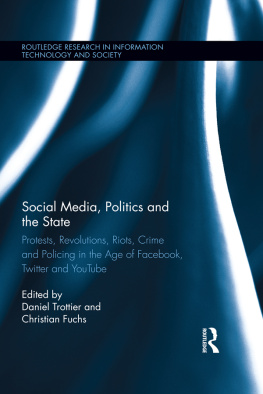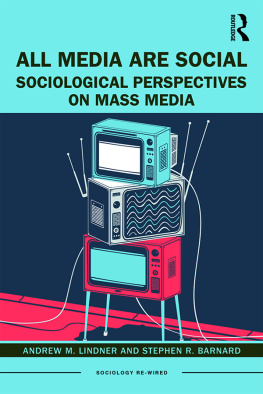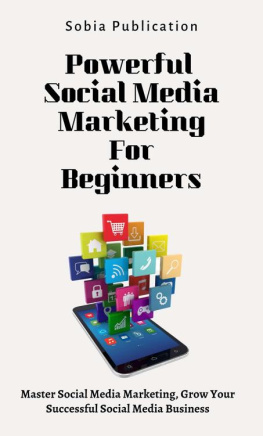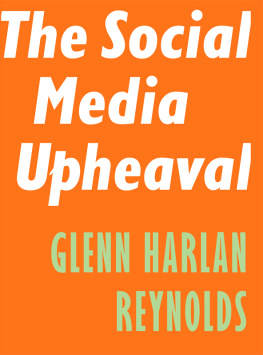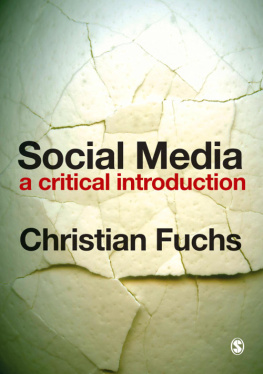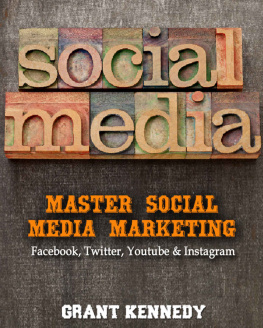The purpose of this chapter is to provide a basic framework for the analysis of social media, politics and the state. This topicwhich the authors in this collected volume studycan be situated in the broader field of Internet and social media studies (see Dutton 2013, as well as the contributions in Ess and Dutton 2013 for an overview). Internet and social media research can be conducted in different ways. More administrative approaches analyse how digital media are used by whom, for what purpose, addressed to which audience, bearing which content, and having which effects. In contrast, critical Internet studies go beyond the digital version of the Lasswell formula. They do not exclude studying empirically the cornerstones of digital media use, but always situate such analyses in theorising and analysing larger contexts, such as power structures, the state, capitalism, gender relations, social struggles, and ideologies, which shape and are shaped by the digital media landscape in dialectical processes (Fuchs 2008, 2014d). This collected volume, in studying social media in the context of politics and the state, suggests the approach of critical Internet and social media studies. (See also Fuchs and Dyer-Witheford 2013; Fuchs and Sandoval 2014.)
This chapter is structured the following way: proposes a theoretically grounded understanding of the state, while section six considers the various branches that make up the state. Section seven focuses on politics, as well as the relation between the state and politics. Section eight addresses power, specifically state power and corporate power. Section nine considers crime and policing, with an emphasis on the relation of police to the state. Section ten considers the distinctions between protests, revolutions and riots. Finally, section eleven offers some concluding remarks.
What is Social Media?
It is possible to trace the emergence of social media to when Tim OReilly (2005) introduced the term Web 2.0 in 2005. While OReilly claims that Web 2.0 denotes actual changes whereby users collective intelligence co-create the value of platforms like Google, Amazon, Wikipedia or Craigslist in a community of connected users, (OReilly and Battelle 2009, 1) he admits that the term was mainly created for identifying the need of new economic strategies of Internet companies after the dot-com crisis, in which the bursting of financial bubbles caused the collapse of many Internet companies. So he states in a paper published five years after the creation of the invention of the term Web 2.0 that this category was a statement about the second coming of the web after the dotcom bust at a conference that was designed to restore confidence in an industry that had lost its way after the dotcom bust (ibid.).
Michael Mandiberg argues that the notion of social media has been associated with multiple concepts: the corporate media favourite user-generated content, Henry Jenkins media-industries-focused convergence culture, Jay Rosens the people formerly known as the audience, the politically infused participatory media, Yochai Benklers process-oriented peer-production, and Tim OReillys computer-programming-oriented Web 2.0 (Mandiberg 2012, 2). The question of if and how social the web is or has become depends on a profoundly social theoretical question: what does it mean to be social? Are human beings always social or only if they interact with others? In sociological theory, there are different concepts of the social, such as mile Durkheims social facts, Max Webers social action, Karl Marxs notion of collaborative work (also employed in the concept of computer-supported collaborative workCSCW) or Ferdinand Tnnies notion of community (for a detailed discussion, see Fuchs 2014d). Depending on which concept of sociality one employs, one gets different answers to the questions of whether the web is social and whether sociality is a new quality of the web. Community aspects of the web have certainly not started with Facebook, which was founded in 2004 but was already described as characteristic of 1980s bulletin board systems, like The WELL, that he characterises as virtual communities (Rheingold 2000). Collaborative work, as, for example, the cooperative editing of articles performed on Wikipedia, is rather new as a dominant phenomenon on the WWW, but not new in computing. The concept of CSCW (computer supported cooperative work) was subject of a conference series that started in December 1986 with the 1st ACM Conference on CSCW in Austin, Texas. A theoretical approach is needed that identifies multiple dimensions of sociality (such as cognition, communication, and cooperation), based on which the continuities and discontinuities of the development of the Internet can be empirically studied. Neither is the wiki-concept new itself: the WikiWikiWeb was introduced by Ward Cunningham in 1984. All computing systems, and therefore all web applications, and also all forms of media can be considered as social because they store and transmit human knowledge that originates in social relations in society. They are objectifications of society and human social relations. Whenever a human uses a computing system or a medium (also if she or he is alone in a room), then she or he cognises based on objectified knowledge that is the outcome of social relations. But not all computing systems and web applications support direct communication between humans, in which at least two humans mutually exchange symbols that are interpreted as being meaningful. Amazon mainly provides information about books and other goods one can buy; it is not primarily a tool of communication, but rather a tool of information, whereas Facebook has in-built communication features that are frequently used (mail system, walls for comments, forums, etc.).
The discussion shows that it is not a simple question to decide if and how social the WWW actually is. Therefore a social theory approach of clarifying the notion of social media can be advanced by identifying three social information processes that constitute three forms of sociality:
- Cognition
- Communication
- Cooperation
According to this view, individuals have certain cognitive features that they use to interact with others so that shared spaces of interaction are created. In some cases, these spaces are used not just for communication but also for the co-production of novel qualities of overall social systems and for community building. The three notions relate to different forms of sociality: the notion of cognition is related to Emile Durkheims concept of social facts, the communication concept to Max Webers notions of social actions and social relations, the cooperation concept to the notions of communities and collaborative work. According to this model, media and online platforms that primarily support cognition (such as the websites of newspapers) are social media (1), those that primarily support communication (such as e-mail) are social media (2), and those that primarily support community building and collaborative work (such as Wikipedia, Facebook) are social media (3). This means that social media is a complex term and that there are different types of social media. Empirical studies show that the most recent development is that there is a certain increase of the importance of social media (3) on the Internet, which is especially due to the rise of social networking sites such as Facebook, wikis like Wikipedia, and microblogs such as Twitter and Weibo.
boyd and Ellison (2008, 211) define social network sites as web-based services that allow individuals to (1) construct a public or semi-public profile within a bounded system, (2) articulate a list of other users with whom they share a connection, and (3) view and traverse their list of connections and those made by others within the system. In network analysis, a network is defined as a system of interconnected nodes (Wasserman and Faust 1997; Barabsi 2003). Therefore, based on a strict theoretical understanding, all networked tools that allow establishing connections between at least two humans have to be understood as social network platforms. This includes not only the platforms that boyd and Ellison have in mind but also chats, discussion boards, mailing lists, e-mail, etc.all Web 2.0 and 3.0 technologies. Social network site is therefore an imprecise term. David Beer argues that this definition is too broad and does not distinguish different types of sites such as wikis, folksonomies, mash-ups and social networking sites: My argument here is simply that we should be moving toward more differentiated classifications of the new online cultures not away from them (Beer 2008, 519.). He suggests using Web 2.0, not SNS, as an umbrella term.

